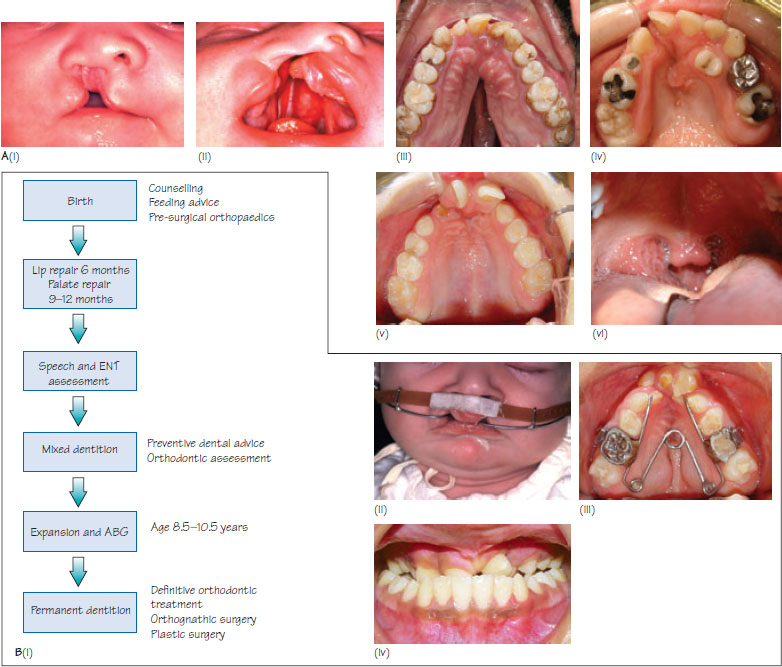44
Cleft lip and palate
Table 44.1 A simplified version of the Kernahan and Stark classification of cleft lip and palate.
| Clefts of the primary palate | Clefts of the secondary palate | Clefts of the primary and secondary palate |
| Unilateral (left or right) | Complete | Unilateral (left or right) |
| Complete | Incomplete | Complete |
| Incomplete | Submucous | Incomplete |
| bilateral | bilateral | |
| Complete | Complete | |
| Incomplete | Incomplete |
Figure 44.1 (A) Examples of cleft lip and palate: (i–iii) unilateral complete cleft of the lip and palate (primary and secondary) (iv) unilateral complete cleft of the lip and primary palate, (v) bilateral complete cleft of the lip and primary palate, and (vi) a bifid uvula which may suggest a submucous cleft. (B) (i) Care pathway for the management of cleft lip and palate, (ii) pre-surgical orthopaedics with lip strapping, (iii) a tri-helix appliance used to achieve expansion before alveolar bone grafting (ABG), and (iv) a Class III relationship that is often evident and requires joint orthodontic-orthognathic treatment.

Cleft lip and palate (CLP) is the most common congenital craniofacial deformity. Its incidence varies according to the ethnic group studied: American Indians (1/300 live births) > Japanese (1/400) > Chinese (1/500) > Caucasians (1/600) > black people (1/2500). Cleft lip (CL) ± cleft palate (CL(P)), forms a separate entity from isolated clefts of the secondary palate (CP), with a difference in incidence, gender bias and genetic contribution. CL(P) is approximately twice as common in males as females, whereas, isolated CP is twice as common in females.
Aetiology
CL arises from failure of fusion (at 7 weeks in utero) between the medial nasal, lateral nasal and maxillary swellings. CP arises from failure of fusion (8–9 weeks in utero) of the lateral palatal swellings.
CLP may be isolated or as part of a syndrome. The aetiology of isolated CLP is multifactorial with both genetic and environmental influences. There is a fami/>
Stay updated, free dental videos. Join our Telegram channel

VIDEdental - Online dental courses


